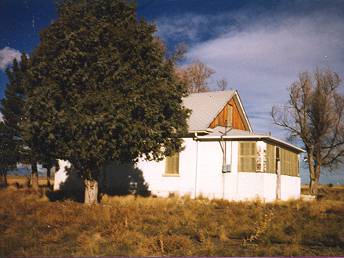Seniors take Rocky Mountain Arsenal Tour
Written in February of 1997
On a warmer than usual February day a bus load of seniors from the Commerce City Recreation Center Adult Senior Program toured the Rocky Mountain Arsenal. Ernie Maurer, the only Arsenal guide who was raised on the land, was the guide for the tour.
The group rode in a double decker bus and was taken to the Visitor's Center, entering on 7th Avenue, which was named for December 7, Pearl Harbor Day. The Visitor's Center at the Arsenal has been remodeled and a new room added to watch videos. A new tram will be put in soon.
 To the north of the Visitors Center is the old Egli home, one of the only original homes still standing on the Arsenal. The Egli house was built in 1912 and the family had eight children, four boys and four girls. Three of the girls are still living, Gladys 86, Rose 85 and Lucille 65. A grove of locust trees north of the Visitors Center began when the Eglis planted one single tree in the 1920s. They put in the tree to act as a marker for their home when the wind whipped the dirt or snow around. Now it is a grove of many trees where deer linger.
To the north of the Visitors Center is the old Egli home, one of the only original homes still standing on the Arsenal. The Egli house was built in 1912 and the family had eight children, four boys and four girls. Three of the girls are still living, Gladys 86, Rose 85 and Lucille 65. A grove of locust trees north of the Visitors Center began when the Eglis planted one single tree in the 1920s. They put in the tree to act as a marker for their home when the wind whipped the dirt or snow around. Now it is a grove of many trees where deer linger.
In the yard of the Egli home two deer stood and watched for intruders. An old crumbled fence still stands by the house and a broken down clothesline speaks of happier days of old.
One half mile north of where the blue post office building now stands on 56th Avenue, close to where Big Ed's Tavern once was, is where 300 German prisoners of war were housed. The POW camp is now gone.
Ernie Maurer's ancestors were immigrants from Switzerland who rode the train to Union Station. They settled on the land that would someday be the Arsenal and wrote and told relatives about the wonderful home they had. When the family came they found a sod hut, five acres of ground and one skinny cow. Their discovery was too late because they had spent their money getting here and couldn't go back to Switzerland. They had to make a living.
Ernie Maurer's Great Aunt Mary was 103 years old when she died a couple of years ago. Now he feels that he can tell how some of the family made a living. It was during Prohibition and Great Aunt Mary delivered milk, eggs and whiskey to the Swanzee area. The "sniffers" couldn't find the still because it was hidden under a manure pile.
The Arsenal now has a Fish and Release Program. There are school tours nearly every day and a program for handicapped youths.
As the tour continued through the Arsenal land the group was told that the Army built Lake Mary, once an Alfalfa field, in 1960. Air-conditioned bunkers which looked like hills were used for storage of mustard gas.
"You can tell this was fertile land," Ernie declared. "There was probably one cow to every 10 acres."
The colorful double-decker bus drove on a road built by the British in 1883, on the east side of the Arsenal where new wetlands are being developed. The upper part of Ladora Lake will be part of the wetlands.
There are approximately 150 white tailed deer and 600 mule deer at the last count on the Rocky Mountain Arsenal Wildlife Preserve.
The group of seniors stopped and walked to the top of a hill where cleanup operations could be seen. One plant that was seen on the way back to the bus was called "Indian Toilet Paper." It is a large, soft plant.
It was a wonderful tour of history, an interesting and developing Fish and Wildlife Preserve and the cleanup of the Rocky Mountain Arsenal, thanks to Ernie Maurer, a great tour guide.


 To the north of the Visitors Center is the old Egli home, one of the only original homes still standing on the Arsenal. The Egli house was built in 1912 and the family had eight children, four boys and four girls. Three of the girls are still living, Gladys 86, Rose 85 and Lucille 65. A grove of locust trees north of the Visitors Center began when the Eglis planted one single tree in the 1920s. They put in the tree to act as a marker for their home when the wind whipped the dirt or snow around. Now it is a grove of many trees where deer linger.
To the north of the Visitors Center is the old Egli home, one of the only original homes still standing on the Arsenal. The Egli house was built in 1912 and the family had eight children, four boys and four girls. Three of the girls are still living, Gladys 86, Rose 85 and Lucille 65. A grove of locust trees north of the Visitors Center began when the Eglis planted one single tree in the 1920s. They put in the tree to act as a marker for their home when the wind whipped the dirt or snow around. Now it is a grove of many trees where deer linger.

